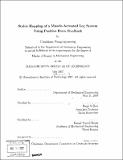| dc.contributor.advisor | Hugh M. Herr. | en_US |
| dc.contributor.author | Wongviriyawong, Chanikarn Mint | en_US |
| dc.contributor.other | Massachusetts Institute of Technology. Dept. of Mechanical Engineering. | en_US |
| dc.date.accessioned | 2007-12-07T16:13:14Z | |
| dc.date.available | 2007-12-07T16:13:14Z | |
| dc.date.copyright | 2007 | en_US |
| dc.date.issued | 2007 | en_US |
| dc.identifier.uri | http://hdl.handle.net/1721.1/39725 | |
| dc.description | Thesis (S.M.)--Massachusetts Institute of Technology, Dept. of Mechanical Engineering, 2007. | en_US |
| dc.description | Includes bibliographical references (leaves 89-92). | en_US |
| dc.description.abstract | In control of movement, two key components, which are pure mechanical response of the system and response due to sensory feedback, must be thoroughly understood. Recent studies suggest not only the existence of positive force feedback in vivo, but also the emergent property of positive force feedback in having a stabilizing effect on a dynamical system in the presence of disturbances. In this thesis, simulated environment of simple one-dimensional point mass hopping model with positive force feedback as well as experimental results of the same dynamical system are compared and studied in detail. Three important hypotheses are investigated. The first hypothesis involves positive force feedback and its stabilization property despite disturbances in the system. A system with positive force feedback control attains cyclic motion while system energy is being added or removed without changing its steady state system energy. Secondly, overall mechanical behavior of the leg becomes elastic in the existence of positive force feedback. In locomotion, elastic leg behavior is desired for a pertinent adaptation to physical properties of the environment and utilization of the locomotory performances. | en_US |
| dc.description.abstract | (cont.) The last hypothesis investigated is the effect of feedback control parameters on closed loop system behavior, i.e. frequency of hopping, steady state hopping height, etc. Simulation and pilot experimental data are compared both qualitatively and quantitatively concerning all three hypotheses. | en_US |
| dc.description.statementofresponsibility | by Chanikarn Wongviriyawong. | en_US |
| dc.format.extent | 92 leaves | en_US |
| dc.language.iso | eng | en_US |
| dc.publisher | Massachusetts Institute of Technology | en_US |
| dc.rights | M.I.T. theses are protected by copyright. They may be viewed from this source for any purpose, but reproduction or distribution in any format is prohibited without written permission. See provided URL for inquiries about permission. | en_US |
| dc.rights.uri | http://dspace.mit.edu/handle/1721.1/7582 | |
| dc.subject | Mechanical Engineering. | en_US |
| dc.title | Stable hopping of a muscle-actuated leg system using positive force feedback | en_US |
| dc.type | Thesis | en_US |
| dc.description.degree | S.M. | en_US |
| dc.contributor.department | Massachusetts Institute of Technology. Department of Mechanical Engineering | |
| dc.identifier.oclc | 180931810 | en_US |
